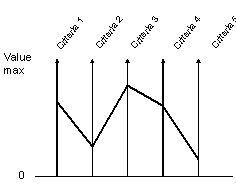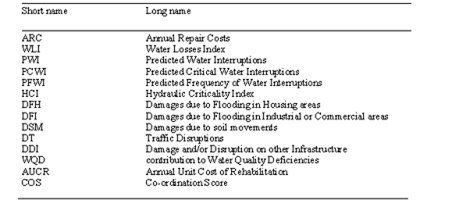 |
 |
 |
 |
 |
 |
 |
 |
 |
 |
 |
 |
Project summary
Name of the case study
Rehabilitation of water supply network in urban fields (CARE-W-ARP)
Where is it located?
France
What type of activity is it?
Rehabilitation
Short description of the case study
CARE-W-ARP is a multi-criterion decision support tool that enables analysis of the whole water supply network to take place in order to produce a prioritised list of rehabilitation pipes for an annual rehabilitation investment programme. CARE-W-ARP was developed during the European Project CARE-W (Computer Aided Rehabilitation of Water Network, February 2001- January 2004) which was funded by the European Community.
CARE-W-ARP considers different aspects of existing deficiencies (failures, leakages, ageing etc) and potential improvements for ranking and selecting pipes. Two types of criteria have been defined: criteria assessing the consequences of the condition of each pipe like expected repair costs or expected impacts of water interruptions, and criteria assessing the opportunity of a rehabilitation project like rehabilitation costs or coordination with other utilities (gas, road works). In addition, information required for the calculation of these criteria is derived from four main sources: 1. Performance indicators (complains rates, valve density etc) 2. Hydraulic Reliability software, 3. Failure prediction tools, and 4. Utility databases. The utility database contains information on the pipe (diameters, length, material use, date of placing etc) and on the pipe environment (number of people supplied, presence of sensible clients etc). Therefore the outranking approach proposes to represent each pipe using a multi-criterion profile which is compared with two reference profiles without aggregating criteria. A multi-criterion profile is the graphic representation of several criteria that have been previously calculated (see below).

Example of multi-criterion profile
The CARE-W-ARP software has been tested on several water supply networks of European cities for example Reggio Emilia (I), Greater Lyon (Fr), Lausanne (CH), with the collaboration of the water services. Different criteria can be used to compare pipes for rehabilitation on a case by case basis, although this will depend on the specific context of the city and data availability (see below).

Criteria definition (source: Le Gauffre et al. 2003)
Several simulations may be run by modifying criteria weights, reference values and/or other parameters. These results can be compared in CARE-W-ARP using sensitivity or robustness analysis.
The use of CARE-W-ARP improves the relevance and justification of the rehabilitation plan and reduces the ageing impacts of the network (water losses, damages, water interruptions etc). It may also improve discussion and dialogues between municipal engineers of the water network and the elected representatives by the increase of transparency and communication.
The PETUS project analyses a range of practical tools which could be used to assess the sustainable dimensions of urban development projects. In order to build on our knowledge of these tools, to judge their potential utilisations and their relevance, two methods can be considered. The first one consists of highlighting a particular tool and observing its use in different projects. The second consists of outlining the different tools implemented in a particular project which incorporate sustainability aspects. This case study belongs to the first category in which the tool in practice is the entry point of the study.
Reference to the concept of sustainable development concept is not directly explicit here. Nevertheless, reports and documents read, supplemented by the discussions with the authors who produced the tools (researchers) and the tool users (the technical services of municipalities) show the construction of a new relevant issue related to practice. We could have chosen to present here one implementation of the CARE-W-ARP tool in a specific city. However, this is the common work between researchers and technical managers, the wish to work together through years and to share means, in relation with the urban water supply network, which insist on the sustainability reference. This case study is, in our opinion, representative of the process that should be encouraged in regard to sustainable practices.
This case study can be related with the PETUS key-problem of the "Water/sewage" section: Management and conception of urban water infrastructures.
What tools were used to assess sustainability?
More information